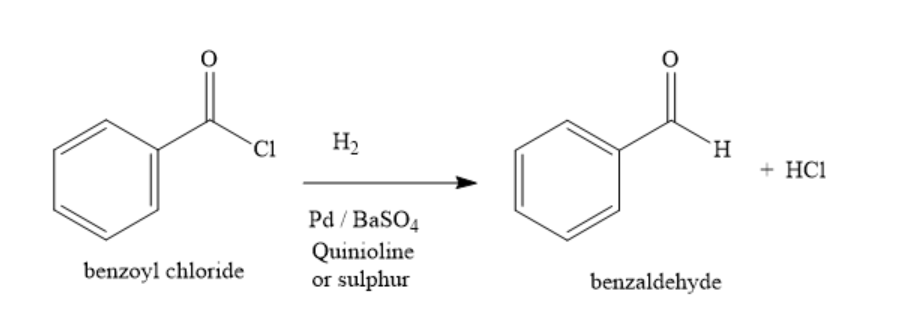
How will you bring about the following conversations?
(i) Propanone to propane
(ii) Benzoyl chloride to benzaldehyde
(iii) Ethanal to but-2-enal.
Answer
480k+ views
Hint: Following changes are occurring:
(i) The carbonyl group is reduced to methylene group.
(ii) Acid chloride group is converted to an aldehyde group.
(iii) Two molecules of aldehyde condense in this conversion.
Complete step by step answer:
The conversion of propanone to propane can be carried out with either Clemmensen reduction or Wolff-Kishner reduction.
In Clemmensen reduction, propanone is treated with zinc amalgam and concentrated hydrochloric acid. Carbonyl group is reduced to methylene group.

In Wolff-Kishner reduction, propanone is treated with hydrazine, followed by potassium hydroxide in a high boiling solvent such as ethylene glycol. Carbonyl group is reduced to methylene group.

The conversion of benzoyl chloride to benzaldehyde is carried out by Rosenmund reduction. Benzoyl chloride is treated with hydrogen and palladium- barium sulphate catalyst partially poisoned with quinoline or sulphur. Acid chloride group is converted into aldehyde group.

The conversion of ethanal to but-2-enal is carried out by aldol condensation reaction. Ethanol is acetaldehyde and contains an alpha hydrogen atom. In presence of dilute alkali, two molecules of ethanal condense to form 3-hydroxybutanal.
Upon heating, this 3-hydroxybutanal loses a water molecule to form but-2-enal.

Note:
(i) Do not use the reagents that reduce carbonyl groups to alcohols.
(ii) Do not use the reagents that convert an acid chloride into an ester or a carboxylic acid.
(iii) Do not forget to add the step for water elimination.
(ii) Acid chloride group is converted to an aldehyde group.
(iii) Two molecules of aldehyde condense in this conversion.
Complete step by step answer:
The conversion of propanone to propane can be carried out with either Clemmensen reduction or Wolff-Kishner reduction.
In Clemmensen reduction, propanone is treated with zinc amalgam and concentrated hydrochloric acid. Carbonyl group is reduced to methylene group.

In Wolff-Kishner reduction, propanone is treated with hydrazine, followed by potassium hydroxide in a high boiling solvent such as ethylene glycol. Carbonyl group is reduced to methylene group.

The conversion of benzoyl chloride to benzaldehyde is carried out by Rosenmund reduction. Benzoyl chloride is treated with hydrogen and palladium- barium sulphate catalyst partially poisoned with quinoline or sulphur. Acid chloride group is converted into aldehyde group.

The conversion of ethanal to but-2-enal is carried out by aldol condensation reaction. Ethanol is acetaldehyde and contains an alpha hydrogen atom. In presence of dilute alkali, two molecules of ethanal condense to form 3-hydroxybutanal.
Upon heating, this 3-hydroxybutanal loses a water molecule to form but-2-enal.

Note:
(i) Do not use the reagents that reduce carbonyl groups to alcohols.
(ii) Do not use the reagents that convert an acid chloride into an ester or a carboxylic acid.
(iii) Do not forget to add the step for water elimination.
Recently Updated Pages
Using the following information to help you answer class 12 chemistry CBSE

Basicity of sulphurous acid and sulphuric acid are

Master Class 12 Economics: Engaging Questions & Answers for Success

Master Class 12 Maths: Engaging Questions & Answers for Success

Master Class 12 Biology: Engaging Questions & Answers for Success

Master Class 12 Physics: Engaging Questions & Answers for Success

Trending doubts
What is the Full Form of PVC, PET, HDPE, LDPE, PP and PS ?

Show variation of resistivity of copper as a function class 12 physics CBSE

Electrolysis of dilute H2SO4 generates H2S2O8 What class 12 chemistry CBSE

Figure shows a conducting loop ABCDA placed in a uniform class 12 physics CBSE

Explain with a neat labelled diagram the TS of mammalian class 12 biology CBSE

The first general election of Lok Sabha was held in class 12 social science CBSE




